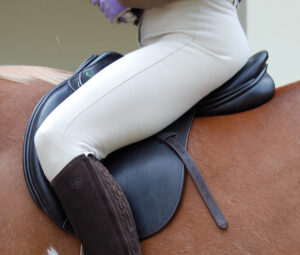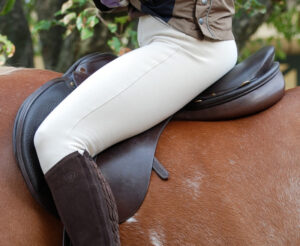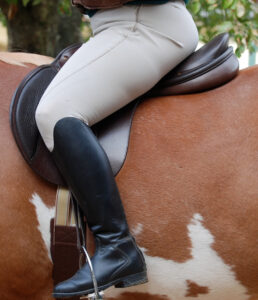Do you feel jammed into your saddle? Or do you feel like you are swimming in it? Does your lower leg flip back over every jump? Have you ever wondered how to determine the correct saddle size for you? The answer to determining the correct seat size for the rider may surprise you.

Next time you ride notice if your knee goes over the flap of your saddle. Do you fight to keep your knee behind the knee block? Do you feel like you are pushed up onto the cantle? Does the curve of the seat begin where your seat bones are or is there a bit of a flat spot for them? Do you always wind up in a chair seat in your saddle no matter how hard you try to keep your leg underneath you? The answer to correctly sizing the saddle for the rider has more to do with the length of your thigh than the size of your buttocks. Therefore if the saddle doesn’t fit your thigh length will not be able to sit correctly.
Most people think that the size of the buttocks is the only consideration for fitting a saddle to the rider. It is important but this is not the only consideration. Very often riders with a long leg are incorrectly placed in a too-small saddle because they have a small buttocks. Riders with short thighs tend to fight the “chair seat” position because their thigh is too short for the saddle. While the flap of the saddle can be made shorter or longer to cosmetically make the rider’s thigh look suited to the flap this does not address the fundamental issue that determines the seat size for the rider.
The critical determinant for the correct seat size is the distance between the stirrup bar and the deepest part of the seat. The stirrup bar is generally attached to the point of the saddletree. Depending on the angle of that point this could place the stirrup bar very far forward if the point angles forward or further back if the point is more upright.

The deepest part of the seat is determined by how the seat is webbed. (The saddle must be sitting level when you locate the deepest point.) When the saddle maker webs (places strips of fabric both lengthwise and crosswise) the tree he can place the deepest part of the seat anywhere along the length depending on how tight he pulls the webbing. If there is more tension at the front of the tree it will pull the webbing closer to the tree thus making the deepest point further forward. If the webbing is pulled tight at the back the deepest part of the seat will be further back.
The distance from the deepest part of the seat to the stirrup bar will determine how you will fit in the saddle. If you have a long thigh you want that distance to be greater, if you have a short thigh you want that distance to be shorter so that your leg will be underneath you.
When riding on the flat a simple rule of thumb to determine the distance is to measure from the ball of your foot to the middle of your ankle. This is approximately the distance you would want from the stirrup bar to the deepest part of the seat. If you think about the classical line of ear, shoulder, hip and ankle it makes sense that when the stirrup is under your foot (the ball) and the classical line is going through your ankle that this distance should be the same in order to create a column of support from your foot to your seat.

When jumping the stirrup length is shorter, the thigh more horizontal, therefore the stirrup bar will be more forward so that the ankle remains under the rider’s hip joint. In this case the longer thigh will need more length in the seat to let the hips move back as the thigh becomes more horizontal.
Use this Murdoch Minute to help you determine the correct seat size. For more information I highly recommend Dr. Joyce Harman’s The Horse’s Pain-Free Back and Saddle-Fit Book and DVDs available for both Western and English saddles.
Wendy Murdoch resides in Washington, VA. She teaches riders of all levels and disciplines how to improve the horse’s performance by improving their body position. Her new book, 50 5-Minute Fixes to Improve Your Riding, based on the Murdoch Minutes, is available beginning July 2010. On-line join Wendy’s Facebook group Fans of the Murdoch Method and find more articles and her blog at www.murdochmethod.com.




